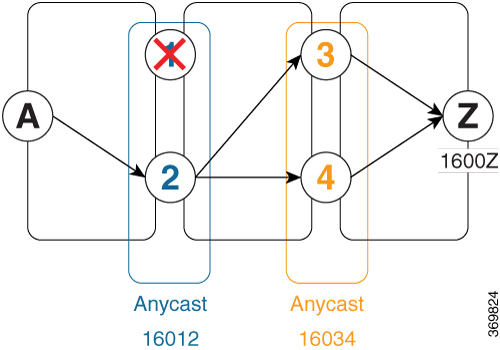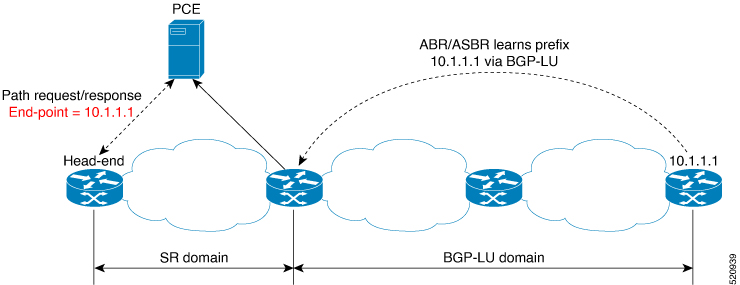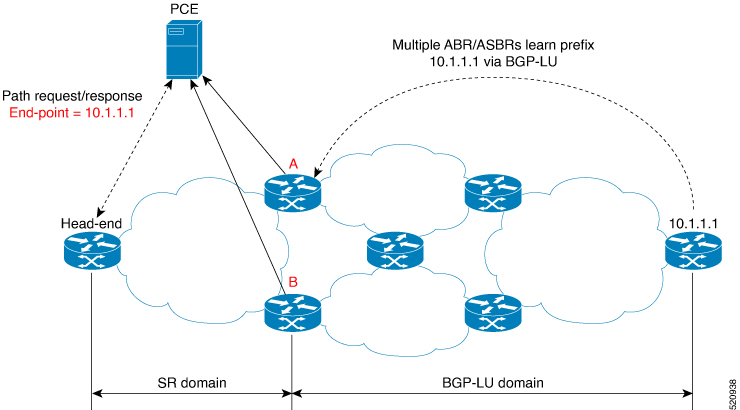About SR-PCE
|
Feature Name |
Release Information |
Feature Description |
|---|---|---|
|
TCP Authentication Option |
Release 7.3.1 |
This feature introduces support for TCP Authentication Option (TCP-AO), which replaces the TCP Message Digest 5 (MD5) option, which was used for authenticating PCEP (TCP) sessions by using a clear text or encrypted password. |
The path computation element protocol (PCEP) describes a set of procedures by which a path computation client (PCC) can report and delegate control of head-end label switched paths (LSPs) sourced from the PCC to a PCE peer. The PCE can request the PCC to update and modify parameters of LSPs it controls. The stateful model also enables a PCC to allow the PCE to initiate computations allowing the PCE to perform network-wide orchestration.
 Note |
For more information on PCE, PCC, and PCEP, refer to the Path Computation Element section in the MPLS Configuration Guide for Cisco ASR 9000 Series Routers. |
SR-PCE learns topology information by way of IGP (OSPF or IS-IS) or through BGP Link-State (BGP-LS).
SR-PCE is capable of computing paths using the following methods:
-
TE metric—SR-PCE uses the TE metric in its path calculations to optimize cumulative TE metric.
-
IGP metric—SR-PCE uses the IGP metric in its path calculations to optimize reachability.
-
LSP Disjointness—SR-PCE uses the path computation algorithms to compute a pair of disjoint LSPs. The disjoint paths can originate from the same head-end or different head-ends. Disjoint level refers to the type of resources that should not be shared by the two computed paths. SR-PCE supports the following disjoint path computations:
-
Link – Specifies that links are not shared on the computed paths.
-
Node – Specifies that nodes are not shared on the computed paths.
-
SRLG – Specifies that links with the same SRLG value are not shared on the computed paths.
-
SRLG-node – Specifies that SRLG and nodes are not shared on the computed paths.
When the first request is received with a given disjoint-group ID, the first LSP is computed, encoding the shortest path from the first source to the first destination. When the second LSP request is received with the same disjoint-group ID, information received in both requests is used to compute two disjoint paths: one path from the first source to the first destination, and another path from the second source to the second destination. Both paths are computed at the same time.
-
TCP Authentication Option
TCP Message Digest 5 (MD5) authentication has been used for authenticating PCEP (TCP) sessions by using a clear text or encrypted password. This feature introduces support for TCP Authentication Option (TCP-AO), which replaces the TCP MD5 option.
TCP-AO uses Message Authentication Codes (MACs), which provides the following:
-
Protection against replays for long-lived TCP connections
-
More details on the security association with TCP connections than TCP MD5
-
A larger set of MACs with minimal system and operational changes
TCP-AO is compatible with Master Key Tuple (MKT) configuration. TCP-AO also protects connections when using the same MKT across repeated instances of a connection. TCP-AO protects the connections by using traffic key that are derived from the MKT, and then coordinates changes between the endpoints.
 Note |
TCP-AO and TCP MD5 are never permitted to be used simultaneously. TCP-AO supports IPv6, and is fully compatible with the proposed requirements for the replacement of TCP MD5. |







 Feedback
Feedback